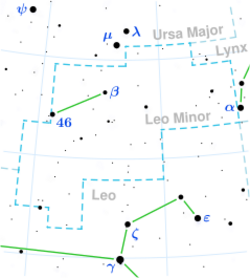Astronomy:8 Leonis Minoris
| Observation data Epoch J2000.0 Equinox (celestial coordinates) | |
|---|---|
| Constellation | Leo Minor |
| Right ascension | 09h 31m 32.41045s[1] |
| Declination | +35° 06′ 11.7793″[1] |
| Apparent magnitude (V) | 5.37[2] |
| Characteristics | |
| Evolutionary stage | AGB[3] |
| Spectral type | M1 IIIab[4] |
| U−B color index | +1.81[2] |
| B−V color index | +1.53[2] |
| Variable type | suspected[5] |
| Astrometry | |
| Radial velocity (Rv) | 39.83±0.18[6] km/s |
| Proper motion (μ) | RA: −54.488[1] mas/yr Dec.: −97.434[1] mas/yr |
| Parallax (π) | 6.6271 ± 0.0238[1] mas |
| Distance | 492 ± 2 ly (150.9 ± 0.5 pc) |
| Absolute magnitude (MV) | −0.43[7] |
| Details | |
| Mass | 1.59[8] M☉ |
| Radius | 48.5[9] R☉ |
| Luminosity | 417±17[10] L☉ |
| Surface gravity (log g) | 1.153[11] cgs |
| Temperature | 3,978±122[12] K |
| Metallicity [Fe/H] | −0.25[1] dex |
| Other designations | |
| Database references | |
| SIMBAD | data |
8 Leonis Minoris (8 LMi) is a solitary,[14] red hued star located in the northern constellation Leo Minor. It has an apparent magnitude 5.37,[2] making it faintly visible to the naked eye. Based on parallax measurements from the Gaia satellite, the object is estimated to be 492 light years distant.[1] It is receding with a heliocentric radial velocity of 40 km/s.[6] At its current distance, 8 LMi is diminshed by 0.12 magnitudes due to interstellar dust.[15]
This is an asymptotic giant branch star[3] with stellar classification of M1 IIIab.[4] It has 1.59 times the mass of the Sun[8] but has expanded to 48.5 times its girth.[9] It radiates 417 times the luminosity of the Sun[10] from its enlarged photosphere at an effective temperature of 3,978 K.[12] 8 LMi has an iron abundance only half of the Sun's, making it metal deficient.[1]
8 LMi's variability was first observed to be variable in 1930 by Joel Stebbins.[16] However, Eggen (1967) instead lists it as an ordinary M-type giant and used the object for comparison.[17] In 1978-9, 8 LMi was again listed as a variable star but did not provide further insight.[18] As of 2017, the star has not been confirmed to be variable.[5]
References
- ↑ 1.0 1.1 1.2 1.3 1.4 1.5 1.6 Vallenari, A. et al. (2022). "Gaia Data Release 3. Summary of the content and survey properties". Astronomy & Astrophysics. doi:10.1051/0004-6361/202243940 Gaia DR3 record for this source at VizieR.
- ↑ 2.0 2.1 2.2 2.3 Ducati, J. R. (2002). "VizieR Online Data Catalog: Catalogue of Stellar Photometry in Johnson's 11-color system.". VizieR Online Data Catalog. Bibcode: 2002yCat.2237....0D.
- ↑ 3.0 3.1 Eggen, Olin J. (July 1992). "Asymptotic giant branch stars near the sun". The Astronomical Journal 104: 275. doi:10.1086/116239. ISSN 0004-6256. Bibcode: 1992AJ....104..275E.
- ↑ 4.0 4.1 Yamashita, Y. (1967). "MK Spectral Types of Bright M-Type Stars". Publications of the Dominion Astrophysical Observatory Victoria 13: 44. ISSN 0078-6950. Bibcode: 1967PDAO...13...47Y.
- ↑ 5.0 5.1 Samus’, N. N.; Kazarovets, E. V.; Durlevich, O. V.; Kireeva, N. N.; Pastukhova, E. N. (January 2017). "General catalogue of variable stars: Version GCVS 5.1". Astronomy Reports 61 (1): 80–88. doi:10.1134/S1063772917010085. ISSN 1063-7729. Bibcode: 2017ARep...61...80S.
- ↑ 6.0 6.1 Famaey, B.; Pourbaix, D.; Frankowski, A.; Van Eck, S.; Mayor, M.; Udry, S.; Jorissen, A. (18 February 2009). "Spectroscopic binaries among Hipparcos M giants". Astronomy & Astrophysics 498 (2): 627–640. doi:10.1051/0004-6361/200810698. ISSN 0004-6361. Bibcode: 2009A&A...498..627F.
- ↑ Anderson, E.; Francis, Ch. (May 2012). "XHIP: An extended hipparcos compilation". Astronomy Letters 38 (5): 331–346. doi:10.1134/S1063773712050015. ISSN 1063-7737. Bibcode: 2012AstL...38..331A.
- ↑ 8.0 8.1 Kervella, Pierre; Arenou, Frédéric; Mignard, François; Thévenin, Frédéric (March 2019). "Stellar and substellar companions of nearby stars from Gaia DR2". Astronomy & Astrophysics 623 (4): A72. doi:10.1051/0004-6361/201834371. ISSN 0004-6361. Bibcode: 2019MNRAS.484.4619G.
- ↑ 9.0 9.1 Kervella, Pierre; Arenou, Frédéric; Thévenin, Frédéric (20 December 2021). "Stellar and substellar companions from Gaia EDR3". Astronomy & Astrophysics 657: A7. doi:10.1051/0004-6361/202142146. ISSN 0004-6361. Bibcode: 2022A&A...657A...7K.
- ↑ 10.0 10.1 Brown, A. G. A. (August 2018). "Gaia Data Release 2: Summary of the contents and survey properties". Astronomy & Astrophysics 616: A1. doi:10.1051/0004-6361/201833051. Bibcode: 2018A&A...616A...1G. Gaia DR2 record for this source at VizieR.
- ↑ Ghosh, Supriyo; Mondal, Soumen; Das, Ramkrishna; Khata, Dhrimadri (29 January 2019). "Spectral Calibration of K−M Giants from medium resolution near-infrared HK-band spectra". Monthly Notices of the Royal Astronomical Society 484 (4): 4619. doi:10.1093/mnras/stz299. ISSN 0035-8711. Bibcode: 2019MNRAS.484.4619G.
- ↑ 12.0 12.1 Stassun, Keivan G. et al. (9 September 2019). "The Revised TESS Input Catalog and Candidate Target List". The Astronomical Journal 158 (4): 138. doi:10.3847/1538-3881/ab3467. Bibcode: 2019AJ....158..138S.
- ↑ "8 Leonis Minoris". SIMBAD. Centre de données astronomiques de Strasbourg. http://simbad.u-strasbg.fr/simbad/sim-basic?Ident=8+Leonis+Minoris.
- ↑ Eggleton, P. P.; Tokovinin, A. A. (11 September 2008). "A catalogue of multiplicity among bright stellar systems". Monthly Notices of the Royal Astronomical Society 389 (2): 869–879. doi:10.1111/j.1365-2966.2008.13596.x. ISSN 0035-8711. Bibcode: 2008MNRAS.389..869E.
- ↑ Gontcharov, George A.; Mosenkov, Aleksandr V. (28 September 2017). "Verifying reddening and extinction for Gaia DR1 TGAS main sequence stars". Monthly Notices of the Royal Astronomical Society 472 (4): 3805–3820. doi:10.1093/mnras/stx2219. ISSN 0035-8711. Bibcode: 2017MNRAS.472.3805G.
- ↑ Stebbins, Joel; Huffer, Charles Morse (1930). "The constancy of the light of red stars". Publications of the Washburn Observatory 15: 140–174. Bibcode: 1930PWasO..15..140S.
- ↑ Eggen, Olin J. (September 1967). "- and Broad-Band Photometry of Red Stars. Northern Giants". The Astrophysical Journal Supplement Series 14: 307. doi:10.1086/190158. ISSN 0067-0049. Bibcode: 1967ApJS...14..307E.
- ↑ Pyl'skaja, O. P.; Zakharova, P. E.; Polushina, T. S. (December 1978). "V-R Colours of Red Variable Stars". Information Bulletin on Variable Stars 1513: 1. ISSN 0374-0676. Bibcode: 1978IBVS.1513....1P.
 |


